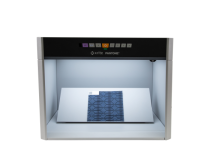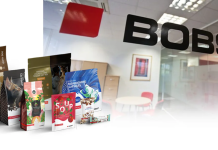Colour is an integral part of every product we see and touch, and it elicits an emotional response. So, when a product fails to meet the intended colour on the shelf or in the showroom, consumers step away from it. This causes a ripple effect of pain from the brand and design team all the way through procurement, suppliers and manufacturing. This article appears in the latest Africa Print Journal.
The process of bringing a product to market is complicated. Like most things in life, the world of our imagination is broader and brighter than what reality will allow. It does not matter if it is a new product or a refresh; taking a product to market involves various parallel development activities, review and revision cycles and many meetings to discuss, review and align on design, colour and materials.
This is reinforced by a recent X-Rite Pantone study of 625 designers, which found that colour was their number one go-to-market challenge. When we sharpened our focus, colour consistency across materials is the common theme. Concurring on colour, defining a standard and leveraging technology to ensure consistent, achievable colour can help remove the pain and frustration created by the constant back and forth between marketing design, technical design and suppliers.
Getting everyone to agree on anything, especially something that can be as subjective as colour, takes time; and there are several steps across the development cycle required to understand not only how colour will behave on a given material, but how the total look and feel of the final product will play in the market. Luckily there are new and innovative solutions on the market that help designers understand how colour will look on various materials. These solutions can provide a designer with the tools to develop and gain agreement on palettes earlier in the design cycle.
A Team Effort
When verifying colour quality, it is common for designers and suppliers to view items outside in natural daylight. But natural daylight varies wildly depending on geography, season, time of day and overall weather conditions. The best way and the most commonly overlooked activity is to evaluate colour with controlled lighting provided by a light booth. Depending on the product or industry, D50 or D65 Daylight is the standard viewing condition for approvals.
Designers should also view samples under the lighting conditions where the product will appear — for example, store or home lighting. Increasingly that also includes LED lighting, a lighting condition that many light booths still do not support, and one with no defined industry standard.
Clients or other team members may not be aware of how important this step is and may not have access to a light booth. That’s why we developed a simple tool, our Pantone Lighting Indicator stickers, that can quickly allow individuals to determine if the viewer is in appropriate lighting conditions. I'm always amazed at people who say they approved the colour from their hotel room or office without understanding the negative impact that this decision can have, and the unneeded costs and cycles that result from approving colour without using controlled lighting.
Colour And Material Challenges
Another recent study from X-Rite Pantone reinforced the fact that getting to and maintaining accurate colour is a top concern among brands and designers. Breaking down the results in more detail reveals that consistent colour across suppliers and achieving accurate colour on target materials/substrates are leading challenges.
For many designers, inspiration occurs in the real world and is often captured as an image. This image, usually an RGB image, is moved into Photoshop where colours are identified. At this stage, CMYK values, L*a*b or HEX values, or a Pantone colour value can be used. There are many tools like Pantone Studio that allow a designer to quickly and easily capture an image and automatically send it to Adobe software, or promote their palette on social media or email. The challenge is many of the most common colour spaces used by designers only work within a physical realm.
Designs move between the digital and physical worlds during the development process. Designs are digital; physical samples are produced from those designs; digital designs are modified to better achieve design intent based on physical sample results, and so on. Even after a product launch, there is a continued balance and having a physical and digital standard for products that will help streamline colour communications and rework. The nature of a company’s products and materials, the complexity of a supply chain, and internal innovation will determine whether a brand works with a visual standard, a combination of visual and digital standards, or has moved to a completely digital colour standard.
CMYK, L*a*b, and Pantone values can all help communicate colour and guide a design team through the creation stage of the physical product. But with the back and forth between the physical and digital worlds, it is important to keep in mind that monitors and screens may not always reflect colour and appearance of your product in the same way a physical sample does; they are simply a different vehicle for viewing colour. Materials all behave differently, light will reflect and diverge, and formulations will vary by region and materials on hand. When designing, it’s important to choose colours that are actually achievable on the target material and colours and material that can be manufactured, not just colours that look good on the screen.
This can be achieved by working with colour standards early in the process. This includes colour standards like Pantone TCX for Fashion and Home produced on cotton, or for a limited colour set, even nylon. There are also many Pantone standards for plastics, paint, metallics, and paper. Using these standards as a guide is a first step in ensuring that colours can be manufactured. Leading brands also engage the Pantone colour Institute to help develop unique brand colours or palettes on a wide variety of materials beyond the product standards the company provides off the shelf.
Working with tools that simulate colours on specific materials is another great place to start. Tools like PantoneLIVE colour Book and Viewer allow packaging designers to create, simulate their colour on the packaging material and finally specify those colours to suppliers. This way a designer can quickly see how a colour will appear on Kraft board versus a white backing material or other materials that may be part of the total package or display. This gives designers the ability to accurately visualise their design in Illustrator and make colour decisions much earlier in the process. Providing designers with tools that visually represent colour on material minimises rejects and rework, and the frustration that can be caused by getting too far down the path with colours that are not achievable on the target material.
There are even more innovative technologies underway that allow brands and manufacturers to capture not only colour, but all of the appearance characteristics of a particular material, and incorporate that data into design decisions. X-Rite’s Total Appearance Capture (TAC) ecosystem is an appearance measurement solution that brings a new level of accuracy and efficiency to the capture, communication and digital presentation of physical materials in the virtual world. TAC enables designers, 3D artists, material specifiers and marketers to bring their product designs to life with digital materials that have the exact same visual characteristics as their physical counterparts. Thought leaders in industries like automotive and leisurewear are moving rapidly to adopt this innovative approach to a seamless and realistic virtualisation from design through product development.
Data Is Your Friend
Once everyone agrees on a colour, the final standard is measured using a spectrophotometer. There are different types of spectrophotometers, and the right type must be selected based on the products manufactured and the defined tolerances. Designers might start by working in RGB or HEX. They may make their way to a CMYK colour or a spot colour like Pantone. At some point, the colour is measured, and L*a*b is the most frequent colour space used at this point. However, everyone is better served by using spectral data that is the result of the colour being measured by an appropriate spectrophotometer.
Spectral data is device independent and all other colour formulas like RGB, CMYK, extended colour gamut or custom formulas can accurately be derived from spectral data. 'When you measure a colour with a spectrophotometer, the spectral data that you get is like the DNA of that colour,' said Brian Ashe, solutions architect for X-Rite Pantone. 'That data can be of real value for anyone because it gives excellent guidance on hitting that colour when it is run on different substrates using different processes, or predicting how the colour will look under different lighting conditions.' Few designers, brands and even some manufacturers may know what spectral data is, but within a complex supply chain that requires accurate and achievable colour, it is simply your friend.
In most supply chains, a variety of different brands and models of instruments are used, and results can vary. Laboratory managers or material specialists will use higher end equipment that holds to a fixed threshold. Doing so ensures that the most accurate colour specification is communicated at the beginning of the process. On the other hand, a simple quality check tool may be used to check production, where the tolerance is not as tight. In either case, the instrument choice is key: once you make that decision, you set the standard for the balance of the process. A colour-critical product like a best-selling men's shirt that needs to coordinate with other apparel items may have a need for a tighter tolerance than, say, faux jewellery that has lower development costs or may be a short seasonal item with simpler expectations. The determination about acceptable colour variance is generally made between procurement, QA, and the Product Design teams.
Needle In A Haystack; Making Data Your Friend
Data accumulated in Product Lifecycle Management (PLM) solutions can be confusing because many people are feeding information into the system simultaneously, and data entry may not always be consistent. Having a set of defined processes for colour data entry, data management and supplier auditing can help streamline operations and avoid problems later on, for designers, brand owners, suppliers, retailers and ecommerce operations.
The other consideration is the fact that we operate in a global environment. This requires sharing data and verifying colour quality across oceans and time zones. When something goes wrong, it can be time consuming to identify and correct the problem. Ensuring there is a standard process in place for entering PLM data (HEX, RGB, CMYK, spectral data or any standard like Pantone) across the entire supply chain is critical. We work in a digital and physical world where brand colours need to be consistent across a multitude of digital and physical products. PLM serves several customers.
The e-commerce team leverages the data in the bill of materials (BOM) to create the online experience, while suppliers need to understand the tolerances and production process steps to put the product together. Adhering to a defined process removes confusion that can occur when multiple standards are being used.
Instrument auditing tools like NetProfiler and those built into colour measurement instruments and software can ensure the measurements at the supplier level are meeting standards and specifications. It’s great if a supplier can meet your quantity and costs, but products that do not meet colour tolerances can impact sales. Having the ability to assess if a supplier is working to your specifications is of value and these types of tools offer the ability to trace back and identify the source of the problem. Software that monitors and checks the devices is like an engine light on a car, informing the driver when to take the car in for an oil change. Leveraging such tools enables brands and complex supply chains to operate with standard work processes, driving consistency and reducing costly colour mistakes before they occur.
Marriage Of Colour And Material
Designs begin in 2D using apps like Adobe Creative Cloud, and many of today’s designs eventually enter the 3D realm. X-Rite has been innovating here by focusing on the automotive industry with its new appearance and visualisation solutions. With the TAC scanner, physical materials can be scanned, capturing both colour and material appearance, and easily migrated to the digital world. This approach streamlines the development process and significantly reduces the time that designers spend manually adjusting digital files. Designers can now move to photo-realistic digital assets that more accurately represent the appearance of the final colour and material in a 3D design.
The TAC Scanner is one part of the TAC ecosystem. The ecosystem includes a controlling hub, called PANTORA, which allows users to store, manage, view and edit digitally captured materials and to exchange these materials, via the Appearance Exchange Format (AxFTM), with today’s leading PLM and CAD systems. The TAC Virtual Light Booth can be used to evaluate digitised materials rendered on virtual objects under multiple lighting conditions and in direct comparison to physical samples.
By engaging the TAC ecosystem, the design to manufacturing process can be sped up even further. In the automotive space, it is projected that material appearance technology solutions will help reduce the cycle time for approving colour on material and accelerate speed-to-market. Having a photo-realistic digital material library based on standard formats also provides colour and material consistency in virtual designs from one platform to another. This offers brands a new way to communicate both colour and appearance, internally and externally.
Innovation In Manufacturing
Today’s manufacturing workflows are digital, but we work within a physical world. We need to help designers, both 2D and 3D, work seamlessly across both worlds by providing them with relevant insights that help them make reasonable and rational decisions upfront. There is no magic wand that automatically ensures colour consistency across materials and manufacturing processes, but today’s tools and solutions make it easier than ever to understand the limitations of materials, how best to formulate colour for those materials, and why it is important to use spectral data to evaluate whether colour conforms to the established standards.
When you triangulate those three, a new world of colour opens up that provides designers and brand managers with the colour and material palettes that enable them to confidently and consistently produce products across a wide range of materials. That’s the end game, and that’s where this next-generation of colour innovation is taking us.





















